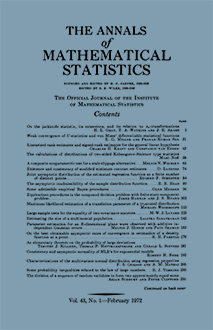Abstract
A type of population frequently encountered in extensive samplings is one in which the variance within a group of elements increases steadily as the size of the group increases. This class of populations may be represented by a model in which the elements are serially correlated, the correlation between two elements being a positive and monotone decreasing function of the distance apart of the elements. For populations of this type, the relative efficiencies are compared for a systematic sample of every $k$th element, a stratified random sample with one element per stratum and a random sample. The stratified random sample is always at least as accurate on the average as the random sample and its relative efficiency is a monotone increasing function of the size of the sample. No general result is valid for the relative efficiency of the systematic sample. In fact, there are populations in the class in which the systematic sample is more accurate than the stratified sample for one sampling rate, but is less accurate than the random sample for another sampling rate. If, however, the correlogram is in addition concave upwards, the systematic sample is on the average more accurate than the stratified sample for any size of sample. Some numerical results are given for the cases in which the correlogram is (i) linear (ii) exponential.
Citation
W. G. Cochran. "Relative Accuracy of Systematic and Stratified Random Samples for a Certain Class of Populations." Ann. Math. Statist. 17 (2) 164 - 177, June, 1946. https://doi.org/10.1214/aoms/1177730978
Information





